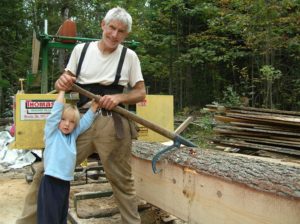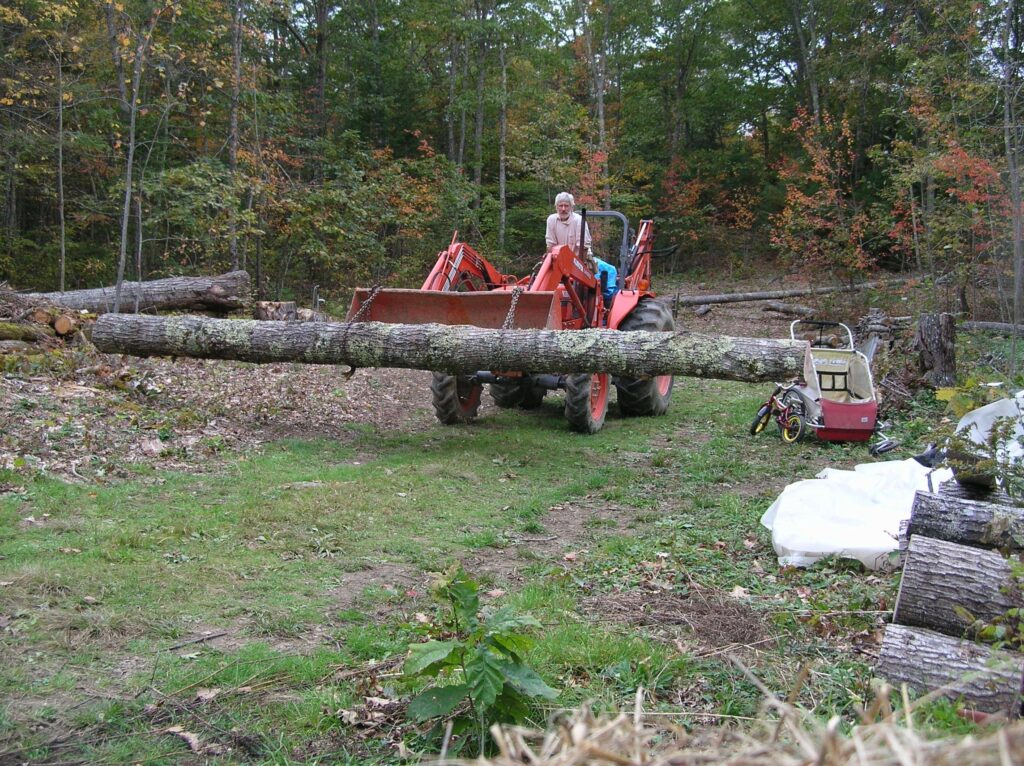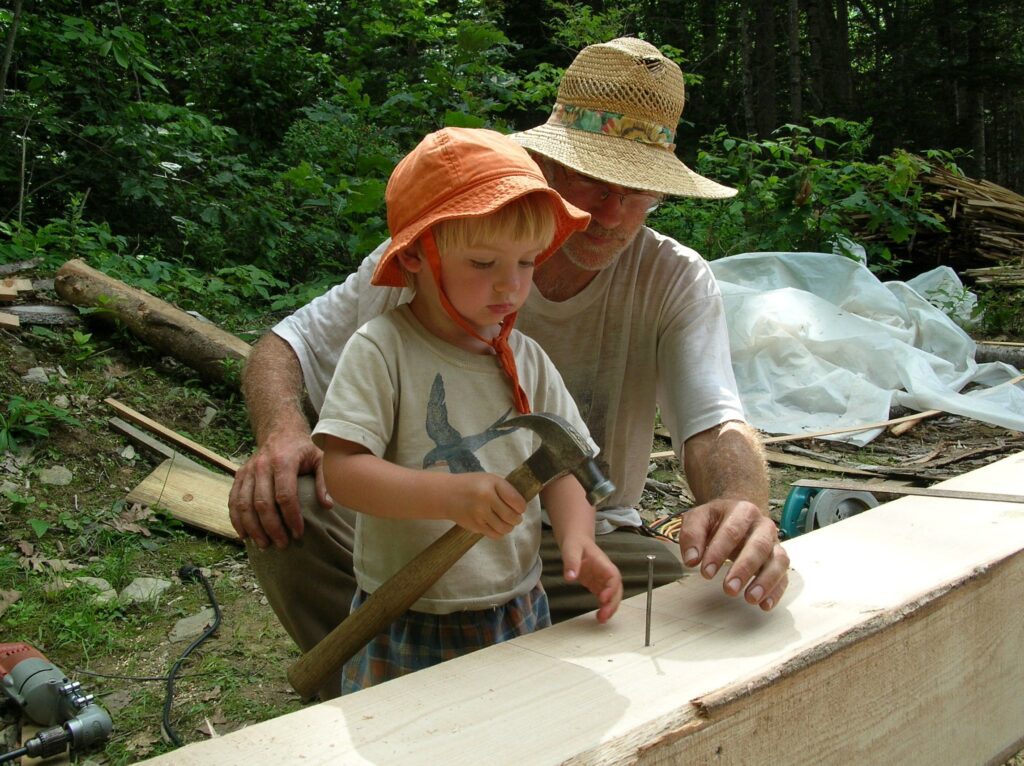Where I live in rural Maine, on every bike ride I see new people moving to our community. A phenomenon that is being called the “big quit” or “the great resignation” is in full swing. After COVID reshuffled the deck of our lives, we had time to reflect. Some 49 million US workers quite their jobs in 2021 and another 50 million quit in 2022. LIFE SHORT. JOB IS NOT FUN. NO MEANING. So they come to Maine’s iconic coastline, buy any home or lot left on the market, buy the last few packets of seeds from the local hardware store, and start to dream.
They say it takes a disaster for a human to change. Now we could say, pick your disaster. Mine was the Valdez Oil spill in 1989, and that was my entry point to homesteading. I was in San Luis Obispo, California, when I couldn’t go to work one more day. After 13 yard sales, I rented three of the four rooms in my house, took the car off the road, and planted a vegetable garden.
My experiment was an urban Thoreau homestead on a tiny suburban lot. I rented a jackhammer and removed the driveway to make room for vegetables. 34 years later, I understand less and less of the mysteries of how seeds lay dormant until… yet, they produce more and more with each passing year.
With this latest disaster, call it COVID, homesteading has surged in popularity. This “great resignation” could be called the “great enlistment,” as in, signing up for something exciting. The haunting lure of paradise — a self-sufficient lifestyle: growing food, collecting chicken eggs in a basket, and harvesting the sun with semiconductors, running blenders, and boom boxes.
This experience rewards those who choose it with sustainability, independence, and a deeper connection to the natural world. Within this article, we will provide a comprehensive guide to homesteading, including its intriguing history, the numerous benefits that come along with it, the challenges that are present, and practical tips to begin your own homesteading journey. Also bring our film Saving Walden’s World to your community to get this conversation rolling.
What is Homesteading?

Homesteading is the beautiful practice of living a self-sufficient lifestyle. Each person or family will choose what to grow, what to sell, how to recycle waste, and the potential for energy production. This way of life values sustainability, independence, and a deep connection to nature.
The beauty of homesteading is that it can manifest in various forms, ranging from a small urban garden to a full-scale farm in a rural area. At its core, homesteading is about taking control of your life and reducing your dependence on the modern consumer economy. By producing your food, energy, and other necessities, you can actively reduce your environmental impact, save money, and enjoy a more fulfilling and meaningful life.
The History of Homesteading
Homesteading has an intriguing history that dates back to the Homestead Act of 1862, which offered land grants to those who were willing to move west and establish farms. The sinister reality was that this Act was meant to steal land from the indigenous peoples who had deep and sustainable land use practices, and replace them with white Europeans who had horribly unsustainable land use practices. But prior to this act of brutality, the word’s origins were less troubled and generally meant “a lot of land adequate for the maintenance of a family.”
Homesteading continued to flourish throughout the 20th century, particularly during the Great Depression and World War II. These times of economic hardship served as motivation for people to turn to homesteading as a means to provide for their families and reduce their dependence on the consumer economy.
In modern times, homesteading has seen a resurgence since the 1960s with the back-to-the-land movement. Young people left the cities and settled where land was cheap. It was a political statement against the Vietnam War and the corporations that profit from the misery of others. These brave youth withdrew their allegiance to the mighty gods of church, state, and corporations and pledged allegiance to the Earth. Many travelled to India to find inspiration for more spiritual homesteading. They returned with a wisdom nugget from Gandhiji’s — “Live simply so that others might simply live.”
The rise of organic farming, farmers’ markets, and community-supported agriculture has made it easier for individuals to access fresh, locally grown food. Many people are now turning to homesteading as a way to take control of their food supply, embrace a deeper connection to nature, and ultimately reduce their environmental impact.
In filming Saving Walden’s World, a remarkable realization emerged. In Kerala, India, high in the western Ghats, the Kudumbashree farmers had read “One Straw Revolution” a favorite in permaculture circles. In Cuba, Leidy Casimiro spoke of David Holmgren, the Australian permaculturist. This world wide web of people, similar to plant connectivity running like mycelium, are helping us recover our sanity.
And in Slovenia, I cycled through the countryside, where almost every home had a garden. It was there that Mihelca Obrovnik, a woman farmer who put words to a buried feeling;
“Working in the garden is like relaxing. Your mind can get empty there. It’s like therapy. I go to the garden to relax. Not to listen to politicians, television, and so on. Because of all the stress in our lives.”
What is Homesteading Land?
Homesteading land refers to a piece of land that is utilized for homesteading activities such as growing crops, raising animals, and constructing structures for living or working on the land. When looking for homesteading land, there are several essential factors to consider. The first is the size of the land required, which will depend on the activities planned and the number of individuals residing there.
Additionally, the location of the land is critical, and a rural area has benefits because it is far from the noise and bustle of city life, offering a more tranquil and natural setting. However, living out in the sticks without public transit can tether you to an automobile, emitting copious amounts of pollution and climate-changing carbon.
It took us three years to find the right piece of land. We had long check lists of what was important to us. You can improve the soil, but if all the roads leading to the schools are choked with traffic, you’d never let your kids cycle to school. We eventually found land, a 15-minute bike ride on lightly travelled roads to town, schools, the library, the food coop, and several bakeries and cafés. I was hoping to find land with a creek to generate electricity, but that dream will have to wait until my next life.
In addition to the size and location, the soil quality and availability of natural resources such as water are critical for the success of the homesteading activities. If the owner will let you spend a few nights in a tent sleeping on the land before you buy it, that will help immensely. Walking, observing nature, and watching animal migrations all inform what to do and what to protect before you become a bull in a China shop.
Finding the right piece of land for homesteading is best achieved by making friends, cycling around, talking to people, and possibly collaborating with a real estate agent who is experienced in this area. They can assist in identifying properties that meet your specific needs and provide guidance on zoning laws and legal considerations.
I spent a lot of time walking, sitting, going on Google Earth, getting tax maps, and even calling the owners of vacant lots. I was driving Susan a bit crazy. I was hoping to find land where I didn’t hear traffic. That proved to be difficult. We lived in a yurt while we milled the wood for our house and planted the orchard. In the yurt, you can hear everybody racing off to work. I had to train my mind to see my good fortune—to not be in a car heading to a job I didn’t like.
We didn’t get every item on our list, but, we held out for the important ones, such as, bike-friendly. Our soils weren’t great, but every year they get better. By selecting the right land and investing time and effort into developing it, you can establish a flourishing homestead that provides for you and your family for years to come.
The Benefits of Homesteading
If homesteading results in a native American holocaust, there is no benefit. If we exploit the land, clear a forest, or drain a swamp, we deprive wildlife from using it. The land I occupy, I steal from other life forms. There is no ecological “free lunch.” What I eat, another species can’t also eat.
But by living lower on the food chain, having a dozen chickens, for example, we can minimize what we take from nature. Large animals such as cows and horses will displace large swaths of desperately needed habitat. Alternatively, we can rewild our homestead, restoring habitats for other species while using permaculture and agroecological practices on the portion of land we utilize for OUR consumption. After years of observing the wild parts of our land, we might come to the realization that we don’t have to be this horribly destructive creature.
In this case, our hard work can bring a wealth of benefits, not just for our family but to the planet and society as a whole.

One of the most significant advantages of homesteading is that we learn by doing that we have agency. This can empower our work towards societal solutions. By producing the necessities of life, you can reduce your environmental impact and contribute to a more sustainable way of living.
Another major benefit of homesteading is the increased level of self-sufficiency it provides. Homesteaders are able to reduce their dependence on the modern consumer economy and take greater control over their own lives. This can lead to a greater sense of empowerment and a more fulfilling way of life.
In addition to these benefits, homesteading can also promote health and well-being by providing access to fresh, healthy food and opportunities for outdoor exercise. Homesteaders can also build strong communities by fostering connections with others who share a common goal of self-sufficiency and sustainability. Finally, homesteading can be a cost-effective way to produce your own food and other necessities, potentially saving you money in the long run.
The Challenges of Homesteading
Let’s face it, the time commitment required, particularly during the growing and harvest seasons, is considerable. Think hot, sweat, dirt, mud, chicken poop, and mosquitoes. Then think about pests eating your crops, blights, fungus, diseases, droughts, wind storms, etc. You can lose a lot of hard work quickly. After doing it, you will want to pay the farmer double their asking price.
Additionally, homesteading involves learning a variety of skills, from gardening and animal husbandry to food preservation and renewable energy production. Starting a homestead also requires an initial investment of time and money, particularly if you need to purchase land, equipment, and supplies. It can be physically demanding, particularly if you’re starting from scratch and need to clear land, build structures, and tend to your garden and animals.
Homesteading is also heavily influenced by weather and climate, which can be unpredictable and challenging to work with.
Is Homesteading Legal?
The answer depends on various factors, such as your location and the activities you plan to engage in on your homestead.
In the United States, homesteading is generally legal, but there may be local zoning laws or regulations that can limit what you are allowed to do on your property. For example, there may be restrictions on the number of animals you can keep or the type of structures you can build.
It’s important to research and understand the laws and regulations that apply to your homestead before starting. This may involve contacting your local government or zoning board to find out what rules you need to follow. It’s also crucial to check if your property is zoned for agricultural use, as some areas may have specific zoning requirements for homesteading activities.
While there are legal considerations to keep in mind, homesteading is generally considered a legitimate way of living. By following the rules and regulations in your area, you can enjoy the many benefits of homesteading while staying within the bounds of the law.
Getting Started with Homesteading
If you’re interested in starting your own homestead, there are a few practical tips that can help you get started on the right foot:
- Land: As the foundation of any homestead, it’s important to choose a property that is suitable for the crops or activities you envision. Soil quality, sunlight, and water access are vital, but also think about the property’s zoning and any local regulations that may affect your plans.
- Equipment: It’s important to invest in high-quality tools that will last. Consider secondhand equipment and DIY solutions to save money. Prioritize the tools you’ll use most frequently and invest in additional equipment as needed.
- Start Small and Plan Ahead: Don’t try to do everything at once. Instead, focus on a few key activities, such as gardening or raising chickens, and gradually expand your homestead as you gain experience and resources. Having a long-term plan will help you achieve your homesteading goals.
- Build a Homestead Network: Homesteading can be a solitary endeavor, but it’s important to build a homestead network of like-minded people who can provide support, advice, and resources. Join a local homesteading group or attend homesteading conferences to meet other homesteaders and learn from their experiences.
- Learn Essential Homesteading Skills: Take classes, read books, and seek out mentors to learn these essential skills. This will help you become more self-sufficient and successful in your homesteading endeavors.
By following these practical tips, you can start your own homestead and enjoy the many benefits of a self-sufficient, sustainable lifestyle.
Homesteading Activities
Here are a few key activities to consider when starting a homestead:
- Gardening: Certain perennials, such as fruits, nuts, and berries, can take years to mature. Spacing and shading will be important considerations. Frost protection and season extensions might involve starting plants indoors and tending them until the ground warms and the nights are frost free. There might be many herbs and medicinal plants growing naturally on your site. It is wise to get several plant identification books to learn them, as they might be valuable or important for other wildlife. Consider starting a small garden and gradually expanding as you gain experience and resources.
- Raising Animals: Consider raising chickens for eggs, bees for honey, or goats for milk and cheese. Be sure to research the specific needs and requirements of each animal before getting started. Fencing will be necessary to keep chickens safe from predators, including raptors. We free range our chickens in the fall after the garden is fully harvested. Once we plant seedlings, the chickens must be fenced in, or they will destroy your crop quickly. We find it necessary to clip the wing tips every year, or they will fly out of their yard. We use a moveable electric fence and a chicken tractor to move them to a fresh area every week.
- Food Preservation: Canning, pickling, and dehydrating produce will allow you to store foods that would otherwise spoil for the winter months. Canning can be stored for several years. Freezing is an option to keep for up to a year. Root cellars are very effective in cold climates and can store large quantities of potatoes, carrots, beets, cabbage, and fruits for the entire winter. Cold, dry storage is useful for storing squash, onions, and garlic.
- Renewable Energy Production: Reduce your dependence on fossil fuels and save money on energy costs by installing solar panels, wind turbines, or micro-hydro generators to produce your energy. Heating and cooking with firewood can save money if your land has sufficient area. Burning wood does contribute to climate change, even though trees are potentially “renewable,” it depends on humans using them at a rate slower than their growth. A living tree both sequesters carbon and stores it in the form of its trunk. When it is burned, it releases the carbon immediately into the atmosphere. The compromise is to super insulate your home, and then a fraction of the wood is needed to keep warm through a cold winter.
Conclusion
Homesteading is a way of life that embraces self-reliance, ecological harmony, and an intimate relationship with nature. Though it’s not without its trials and tribulations, many folks have discovered that homesteading can be an immensely gratifying adventure that imparts a sense of meaning, contentment, and kinship with the earth. If you’re keen on exploring the homesteading lifestyle, begin by taking small steps, thinking ahead, and cultivating a sturdy foundation of proficiency, materials, and communal support.
